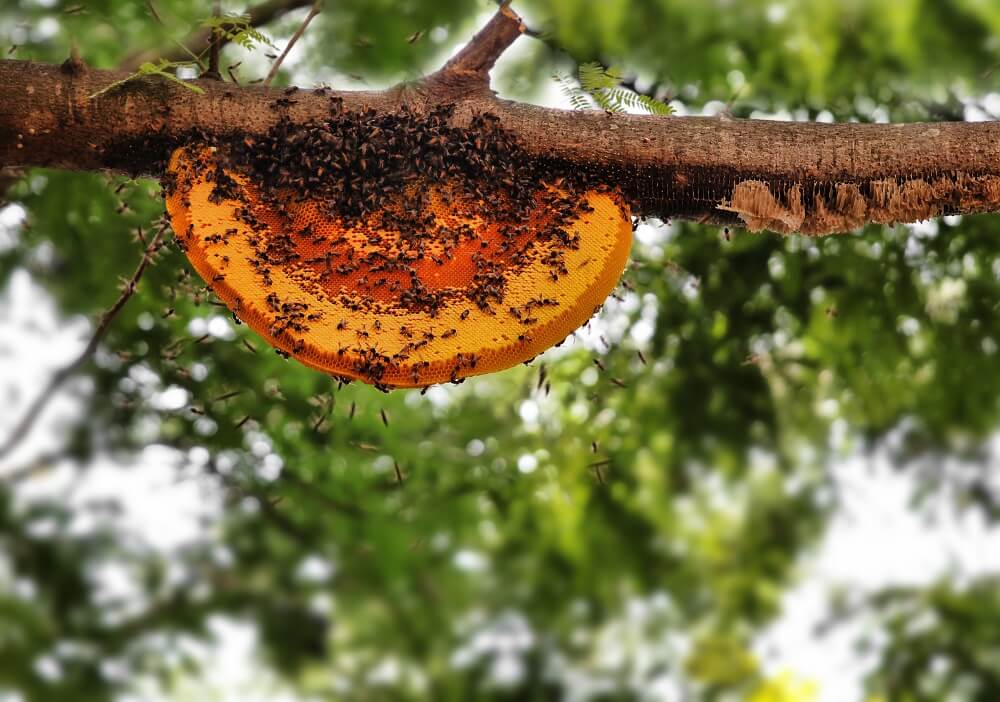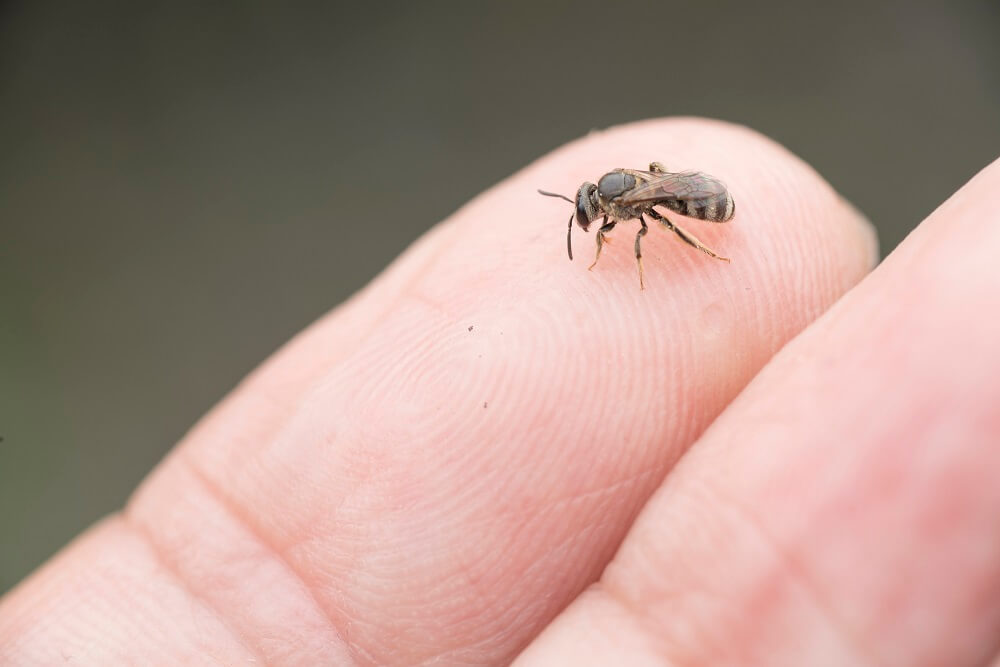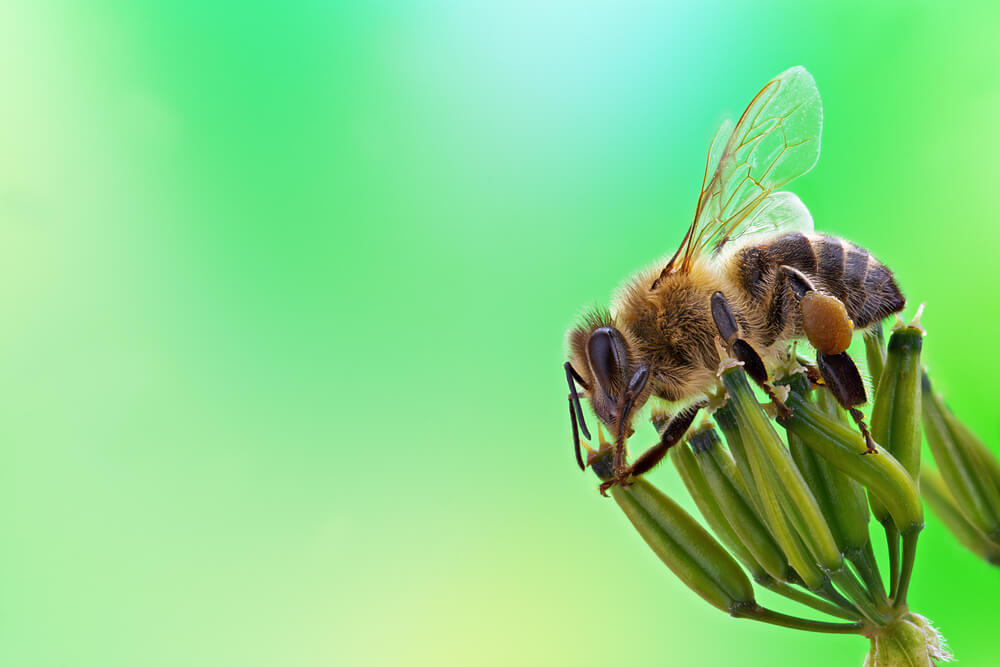Table of Contents:
What Kind of Bees Make Hives in Trees?
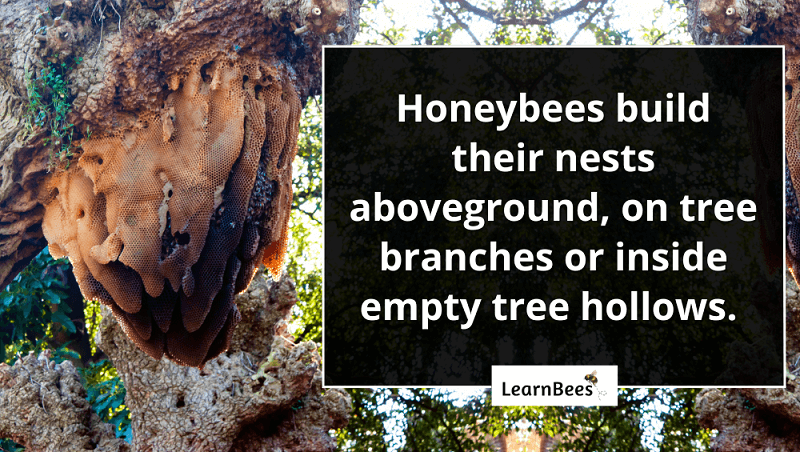
Honeybees are a species of bee that nest on tree branches or inside hollow tree trunks.
Honeybee nests have large pieces of dangling comb. The comb is made of beeswax and is used to store honey and raise baby honeybees.
Interestingly enough:
A single honeybee nest can contain over 50,000 honeybees. Together, these diligent little creatures can produce dozens of pounds of honey per year.
More importantly?
Roughly one in every three bites of food we eat comes from crops pollinated by honeybees.
Many crops rely on pollinators to produce food. Without bees, we’d experience food shortages of certain foods like apples, strawberries, cherries, almonds, melons, broccoli, and more.
This is why farmers rent beehives from beekeepers.
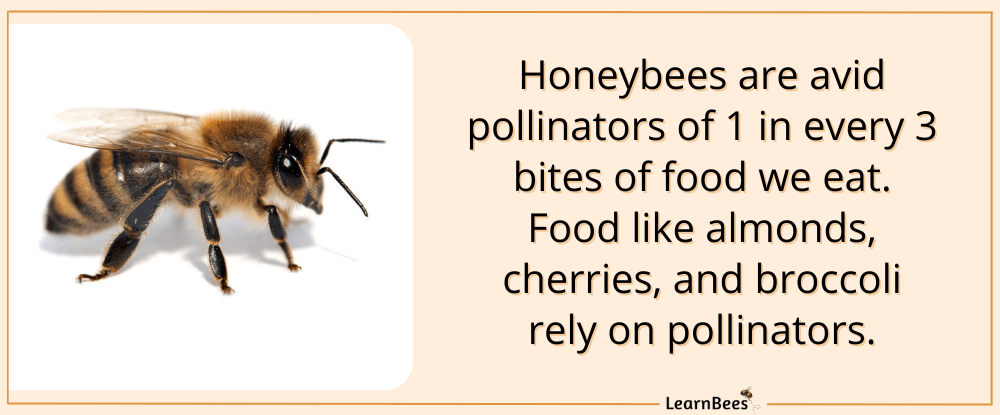
So, in short:
Don’t panic if you find a beehive on a tree.
These busy honeybees are avidly pollinating flowers and crops near you. In fact, honeybees will travel two miles, and sometimes longer, to find flowers to pollinate.
And here’s the good news:
Most honeybees are gentle creatures that leave people, pets, and children alone.
They prefer to keep their distance from people as long as people don’t go poking around their nest.
If you need a honeybee nest removed, contact a local beekeeper for help. Beekeepers will usually relocate the nest for free to save these valuable pollinators.
Do Beehives Harm Trees?
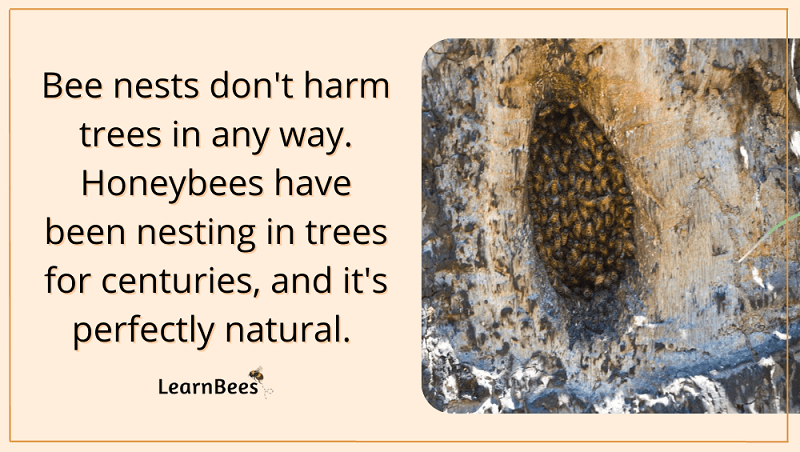
No, beehives don’t harm trees in any fashion.
Honeybees have been nesting in trees for centuries, and it’s perfectly natural for them to do so. This is also true for beehives found inside tree hollows. It’s common, particularly in older trees, for the interior to die off and rot away and not affect the tree’s health in the slightest.
If anything, the honeybees may prevent the tree cavity from expanding since many tree hollows are caused by fungal growth.
How do they do it?
Honeybees use propolis to line their nest, which can kill fungus attacking the tree.
Propolis is an antibacterial and antifungal resin made by bees. It helps them smooth surfaces in their nest and close cracks or holes.
So, don’t worry if you see a honeybee hive nesting on a branch or inside an empty cavity.
If their nest is too close to your home, you can contact a local beekeeper to relocate them. Many beekeepers will save honeybee nests for free.
What Do I Do With a Beehive on a Tree?
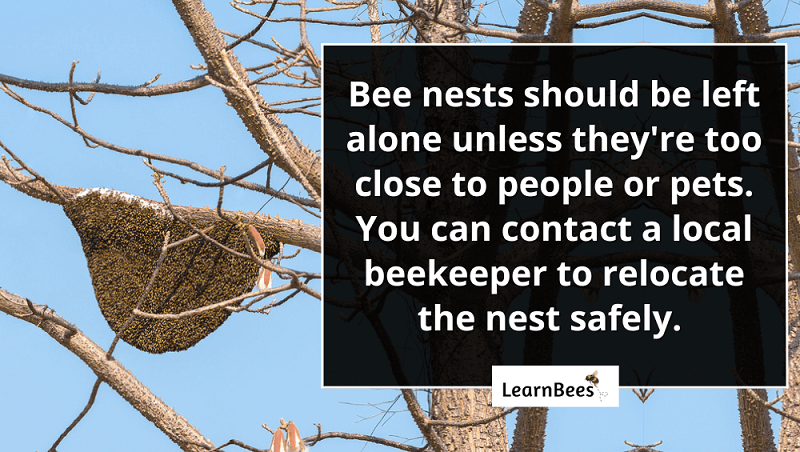
In most cases, you should do nothing.
Allow these vital pollinators to nest in their natural environment undisturbed. Honeybees typically aren’t defensive unless people start digging around their nest.
If you must remove the beehive, for example, if it’s too close to your home:
Find a local beekeeper for help. Many beekeepers will save honeybee nests for free and relocate them to a safer place. Never remove a beehive on your own, as you may get stung.
Remember:
Most honeybees are gentle creatures. However, they will protect themselves if they feel their nest is in danger.
Honeybees must be on high alert because they have numerous predators trying to eat them or their honey. This includes skunks, bears, raccoons, and honey badgers.
Unfortunately, honeybees mistake humans for threats if we get too close to their nest.
So, unless the beehive is causing immediate danger, it’s best to leave it be. These pollinators are critical for our food supply, and we should respect their space.
FAQs for Beehives on Trees
- Will a beehive go away on its own?
- Do all bees make beehives in trees?
- What are the types of beehives in trees?
- There are bees in a tree but no hive. What do I do?
- What do you do if you have a beehive in your tree?
- Why are beehives in trees?
- How long do bees stay in a hive in a tree?
- What type of bees make hives in trees?
- Do beehives in trees attract rodents?
- Are beehives bad for trees?
- What happens if you don’t remove a beehive?
- Do bees stay outside the hive at night?
- What kind of trees do honey bees live in?
- Do bumblebees build nests in trees?
- Do carpenter bees build nests in trees?
- Do bees nest in the tree trunk?
Will a beehive go away on its own?
Bees will go away on their own if they decide they no longer like their nesting spot.
However, the bees are more likely to stay awhile if they’ve already established their nest with many pieces of dangling comb. It’s not uncommon for honeybee nests to remain on trees for several years. In this case, the bees obviously like their spot and feel safe.
It’s best to leave the honeybees alone if they’re not bothering you. Most honeybees won’t purposely try to attack you. Instead, they’ll give you space if you don’t interfere with their nest.
—> Go back to the FAQs for beehives on trees
More to Explore:
- Ground Bees: Are They a Threat to Your Yard?
- Wasps vs. Honeybees: Are They Different?
- Do Bumble Bees Bite?
Do all bees make beehives in trees?
You might be surprised that most bee species don’t build their nests in trees.
In fact, most bee species nest underground. Only a percentage of bee species, such as honeybees, make their nests in trees. It’s estimated that a whopping 70% of bees nest underground.
That said, it’s easiest for honeybees to nest above ground because they build comb. Because it hangs down, the comb is built off branches or structures. This makes it difficult for the honeybees to build their nests in small, dark spaces like underground burrows.
—> Go back to the FAQs for beehives on trees
More to Explore:
What are the types of beehives in trees?
There are two types of beehives in trees: aerial and cavity.
Aerial nests are made by bees that build their comb off branches or structures. This type of beehive is often seen from honeybees.
Cavity nests are made by bees that build their comb inside tree cavities. While this type of beehive is less common, it’s not unheard of. Some species of bees, like bumblebees, will nest in tree cavities if they can’t find a suitable nesting site underground.
However, most bumblebees will nest in empty mouse burrows or piles of vegetation.
—> Go back to the FAQs for beehives on trees
More to Explore:
- Do Carpenter Bees Pollinate?
- How Long Do Bumble Bees Live?
- Honeybees vs. Bumblebees: How Do They Compare?
There are bees in a tree but no hive. What do I do?
It’s best to leave the bees alone. Bees flying around a tree without a hive are likely looking for a place to build their nest.
Most bees build their nests up high enough, so they aren’t a threat to humans or pets. Despite popular belief, bees are gentle insects that don’t go out of their way to cause trouble. Simply give them plenty of space and don’t disturb them.
—> Go back to the FAQs for beehives on trees
More to Explore:
- Do Queen Bees Eat Honey?
- Are Worker Bees Male or Female?
- Queen Bee Versus Worker Bees – How Do They Compare?
What do you do if you have a beehive in your tree?
If the beehive is within a few feet of your home, you can call a local beekeeper to help relocate it. Most beekeepers provide this service for free since they want to save the bees.
If the beehive is far from your home, it’s best to leave it alone. The honeybees are likely not bothering anyone and are providing an important service by pollinating flowers and plants.
Plus, trying to remove a beehive on your own can be dangerous. Without the proper equipment and experience, you could get stung. It’s best to leave it to the professionals.
—> Go back to the FAQs for beehives on trees
More to Explore:
Why are beehives in trees?
Honeybees build hives in trees for many reasons. For one, it’s their natural instinct. Honeybees have been building nests in trees for thousands of years. This is in no way harmful to the tree.
Secondly, honeybees make comb out of beeswax. Comb dangles down from tree branches, allowing the bees to expand their nest easily. They use the comb to store honey and raise bee larvae.
—> Go back to the FAQs for beehives on trees
More to Explore:
How long do bees stay in a hive in a tree?
Honeybees can live inside a tree or on tree branches for years. If they like their nesting location and feel safe, they’re in it for the long haul.
Of course, many factors can cause bees to leave their nest inside a tree. If the nest becomes threatened by predators such as bears, for example, then the bees may decide to find a new location.
—> Go back to the FAQs for beehives on trees
More to Explore:
What type of bees make hives in trees?
Honeybees are the primary type of bee that builds their nests in trees. They use tree branches or empty tree hollows to build dangling honeycombs on.
It’s not uncommon to see a beehive on a tree branch in woodsy or rural areas. Beehives on trees are a part of a bee’s natural environment, and they don’t cause harm to trees in any way.
—> Go back to the FAQs for beehives on trees
More to Explore:
Do beehives in trees attract rodents?
No, beehives in trees usually don’t attract rodents to your property.
—> Go back to the FAQs for beehives on trees
More to Explore:
Are beehives bad for trees?
Beehives aren’t bad for trees at all. In fact, bees are important pollinators that help many trees reproduce.
Additionally, beehives can help trees with empty cavities. Trees with hollows can get that way as a result of a fungus. When the bees build their nest inside the tree, they line it with propolis, a sticky resin with antifungal properties. This can help to protect the tree from further decay.
—> Go back to the FAQs for beehives on trees
More to Explore:
What happens if you don’t remove a beehive?
In most cases, you shouldn’t remove a beehive unless they’re too close to your home or pets. This allows the bees to nest safely without bothering anyone.
Additionally, bees are important pollinators and help keep the ecosystem balanced. If you remove a beehive, you could disrupt the local ecosystem.
It’s best to leave beehives alone unless they’re causing a problem for you or your property. You can contact a local beekeeper to safely relocate them if necessary. Many beekeepers will relocate bees for free because they want to save them.
—> Go back to the FAQs for beehives on trees
More to Explore:
Do bees stay outside the hive at night?
No, bees huddle together around the comb at night. They keep themselves warm by vibrating their wing muscles. If it gets too hot, such as during the summer, the bees collect water and fan it over the comb to cool it down.
—> Go back to the FAQs for beehives on trees
More to Explore:
What kind of trees do honey bees live in?
Honeybees gravitate towards older, established trees like oak, maple, or ash. However, honeybees are opportunists who build their nests in many types of trees, depending on where they feel safest.
—> Go back to the FAQs for beehives on trees
More to Explore:
Do bumblebees build nests in trees?
Bumblebees will occasionally build their nests inside empty tree cavities. This helps protect them from predators and shields them from natural elements like wind or rain.
In most cases, though, bumblebees find nesting locations in empty mouse burrows or large vegetation piles.
—> Go back to the FAQs for beehives on trees
More to Explore:
- How to Repel Bees Without Killing Them
- What Are the Four Stages of the Bee Life Cycle?
- How Long Do Wasps Live?
Do carpenter bees build nests in trees?
Carpenter bees build their nests in trees, but not necessarily in the way you think. Carpenter bees don’t build dangling comb from branches like honeybees do.
Instead, the female carpenter bee uses her strong jaws to drill holes inside the wood. Once she drills her hole, she’ll lay eggs inside it.
These bees usually target softer woods like cedar, redwood, or cypress. They often go for weathered wood over painted or treated wood (such as those found on houses).
Carpenter bees don’t eat the wood they drill into. They simply drill into it to build their nest.
—> Go back to the FAQs for beehives on trees
More to Explore:
Do bees nest in the tree trunk?
Bees can nest in hollowed-out tree trunks. This is perfectly natural and doesn’t cause harm to the tree.
